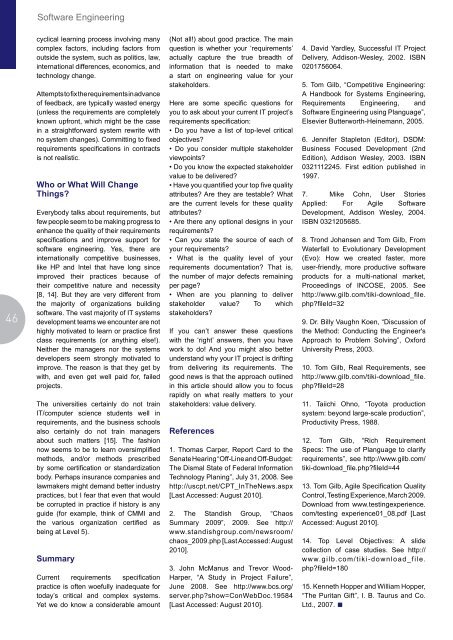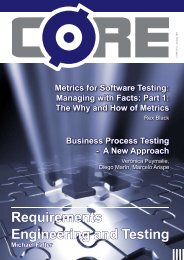Comparison of Change Management Systems
Comparison of Change Management Systems
Comparison of Change Management Systems
Create successful ePaper yourself
Turn your PDF publications into a flip-book with our unique Google optimized e-Paper software.
46<br />
S<strong>of</strong>tware Engineering<br />
cyclical learning process involving many<br />
complex factors, including factors from<br />
outside the system, such as politics, law,<br />
international differences, economics, and<br />
technology change.<br />
Attempts to fix the requirements in advance<br />
<strong>of</strong> feedback, are typically wasted energy<br />
(unless the requirements are completely<br />
known upfront, which might be the case<br />
in a straightforward system rewrite with<br />
no system changes). Committing to fixed<br />
requirements specifications in contracts<br />
is not realistic.<br />
Who or What Will <strong>Change</strong><br />
Things?<br />
Everybody talks about requirements, but<br />
few people seem to be making progress to<br />
enhance the quality <strong>of</strong> their requirements<br />
specifications and improve support for<br />
s<strong>of</strong>tware engineering. Yes, there are<br />
internationally competitive businesses,<br />
like HP and Intel that have long since<br />
improved their practices because <strong>of</strong><br />
their competitive nature and necessity<br />
[8, 14]. But they are very different from<br />
the majority <strong>of</strong> organizations building<br />
s<strong>of</strong>tware. The vast majority <strong>of</strong> IT systems<br />
development teams we encounter are not<br />
highly motivated to learn or practice first<br />
class requirements (or anything else!).<br />
Neither the managers nor the systems<br />
developers seem strongly motivated to<br />
improve. The reason is that they get by<br />
with, and even get well paid for, failed<br />
projects.<br />
The universities certainly do not train<br />
IT/computer science students well in<br />
requirements, and the business schools<br />
also certainly do not train managers<br />
about such matters [15]. The fashion<br />
now seems to be to learn oversimplified<br />
methods, and/or methods prescribed<br />
by some certification or standardization<br />
body. Perhaps insurance companies and<br />
lawmakers might demand better industry<br />
practices, but I fear that even that would<br />
be corrupted in practice if history is any<br />
guide (for example, think <strong>of</strong> CMMI and<br />
the various organization certified as<br />
being at Level 5).<br />
Summary<br />
Current requirements specification<br />
practice is <strong>of</strong>ten woefully inadequate for<br />
today’s critical and complex systems.<br />
Yet we do know a considerable amount<br />
(Not all!) about good practice. The main<br />
question is whether your ‘requirements’<br />
actually capture the true breadth <strong>of</strong><br />
information that is needed to make<br />
a start on engineering value for your<br />
stakeholders.<br />
Here are some specific questions for<br />
you to ask about your current IT project’s<br />
requirements specification:<br />
• Do you have a list <strong>of</strong> top-level critical<br />
objectives?<br />
• Do you consider multiple stakeholder<br />
viewpoints?<br />
• Do you know the expected stakeholder<br />
value to be delivered?<br />
• Have you quantified your top five quality<br />
attributes? Are they are testable? What<br />
are the current levels for these quality<br />
attributes?<br />
• Are there any optional designs in your<br />
requirements?<br />
• Can you state the source <strong>of</strong> each <strong>of</strong><br />
your requirements?<br />
• What is the quality level <strong>of</strong> your<br />
requirements documentation? That is,<br />
the number <strong>of</strong> major defects remaining<br />
per page?<br />
• When are you planning to deliver<br />
stakeholder value? To which<br />
stakeholders?<br />
If you can’t answer these questions<br />
with the ‘right’ answers, then you have<br />
work to do! And you might also better<br />
understand why your IT project is drifting<br />
from delivering its requirements. The<br />
good news is that the approach outlined<br />
in this article should allow you to focus<br />
rapidly on what really matters to your<br />
stakeholders: value delivery.<br />
References<br />
1. Thomas Carper, Report Card to the<br />
Senate Hearing “Off-Line and Off-Budget:<br />
The Dismal State <strong>of</strong> Federal Information<br />
Technology Planing”, July 31, 2008. See<br />
http://uscpt.net/CPT_InTheNews.aspx<br />
[Last Accessed: August 2010].<br />
2. The Standish Group, “Chaos<br />
Summary 2009”, 2009. See http://<br />
www.standishgroup.com/newsroom/<br />
chaos_2009.php [Last Accessed: August<br />
2010].<br />
3. John McManus and Trevor Wood-<br />
Harper, “A Study in Project Failure”,<br />
June 2008. See http://www.bcs.org/<br />
server.php?show=ConWebDoc.19584<br />
[Last Accessed: August 2010].<br />
4. David Yardley, Successful IT Project<br />
Delivery, Addison-Wesley, 2002. ISBN<br />
0201756064.<br />
5. Tom Gilb, “Competitive Engineering:<br />
A Handbook for <strong>Systems</strong> Engineering,<br />
Requirements Engineering, and<br />
S<strong>of</strong>tware Engineering using Planguage”,<br />
Elsevier Butterworth-Heinemann, 2005.<br />
6. Jennifer Stapleton (Editor), DSDM:<br />
Business Focused Development (2nd<br />
Edition), Addison Wesley, 2003. ISBN<br />
0321112245. First edition published in<br />
1997.<br />
7. Mike Cohn, User Stories<br />
Applied: For Agile S<strong>of</strong>tware<br />
Development, Addison Wesley, 2004.<br />
ISBN 0321205685.<br />
8. Trond Johansen and Tom Gilb, From<br />
Waterfall to Evolutionary Development<br />
(Evo): How we created faster, more<br />
user-friendly, more productive s<strong>of</strong>tware<br />
products for a multi-national market,<br />
Proceedings <strong>of</strong> INCOSE, 2005. See<br />
http://www.gilb.com/tiki-download_file.<br />
php?fileId=32<br />
9. Dr. Billy Vaughn Koen, “Discussion <strong>of</strong><br />
the Method: Conducting the Engineer's<br />
Approach to Problem Solving”, Oxford<br />
University Press, 2003.<br />
10. Tom Gilb, Real Requirements, see<br />
http://www.gilb.com/tiki-download_file.<br />
php?fileId=28<br />
11. Taiichi Ohno, “Toyota production<br />
system: beyond large-scale production”,<br />
Productivity Press, 1988.<br />
12. Tom Gilb, “Rich Requirement<br />
Specs: The use <strong>of</strong> Planguage to clarify<br />
requirements”, see http://www.gilb.com/<br />
tiki-download_file.php?fileId=44<br />
13. Tom Gilb, Agile Specification Quality<br />
Control, Testing Experience, March 2009.<br />
Download from www.testingexperience.<br />
com/testing experience01_08.pdf [Last<br />
Accessed: August 2010].<br />
14. Top Level Objectives: A slide<br />
collection <strong>of</strong> case studies. See http://<br />
www.gilb.com/tiki-download_file.<br />
php?fileId=180<br />
15. Kenneth Hopper and William Hopper,<br />
“The Puritan Gift”, I. B. Taurus and Co.<br />
Ltd., 2007.



